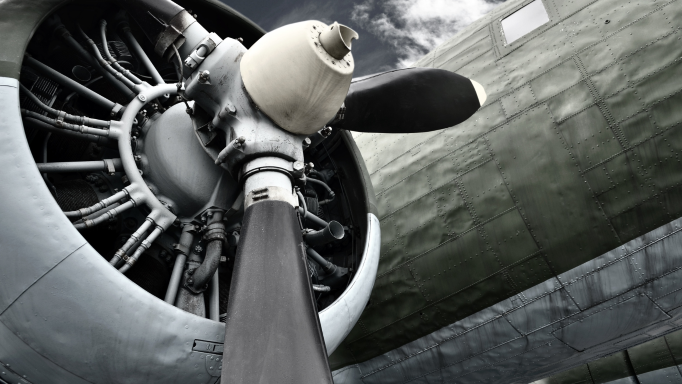
5 Amazing Feats Of Engineering From WWII
08 May, 20205:35Today we celebrate 75 years since the end of World War II in Europe. While we honour those w...

Today we celebrate 75 years since the end of World War II in Europe. While we honour those who gave their lives through the years of fighting, we thank the heroes who stood up for their countries, their families and their beliefs. We will always be indebted to those who made the world a better place for us all.
At Fircroft we celebrate engineers and the awe-inspiring ideas that they turn into a reality. Wartime engineers faced incredible challenges to quickly develop and launch new technologies that would give their armies the edge in the largest conflict the world has ever seen.
So today we’d like to look back on some of the most incredible engineering feats of World War II and the brave, brilliant engineers who worked on them.
The Rolls-Royce Merlin Engine
Iconic aircraft of WWII such as the Supermarine Spitfire, the Hawker Hurricane or the Avro Lancaster bomber could each hold their own place on this list, but instead we’re shining a spotlight on the engine that powered them all - the Rolls-Royce Merlin.
50 versions of the Merlin were built by Rolls-Royce in Derby, Crewe, Glasgow and Manchester, based on the first production design launched in 1936 when it was simply known as the PV-12 engine. It would go on to be used by the RAF in forty aircraft during the war.
The Merlin was a liquid-cooled V-12 piston aero engine. Despite initial problems, expert engineers were able to make continuous improvements that would eliminate any weaknesses. One such example was an improved supercharger designed by mathematician Sir Stanley Hooker, which fixed a power weakness at low altitudes and gave the engine an extra 22mph power boost at low altitudes - an addition that would prove vital to Spitfires and Hurricanes in the Battle of Britain, where much of the combat took place below 6,000 feet.
Another weakness of the engine was that it cut out under negative g force during a steep dive. The problem was solved by female RAF engineer Tilly Shilling, who devised an addition to the float chambers that would come to be known as “Miss Shilling’s Orifice”.
The Merlin engine would continue to be produced for military aircraft until 1950, by which time nearly 150,000 had been made. It is still in use today to power the aircraft of the Battle of Britain Memorial Flight.
Fan Bay Deep Shelter
With the enemy just across the Channel, Britain was in need of serious defences against potential invasion. Artillery shells from France were able to reach the White Cliffs of Dover in just 70 seconds and German ships were clearly visible in the waters - apparently even to Churchill himself, who was enraged by the sight.
The Prime Minister ordered “superior artillery positions on the Dover promontory, no matter what form of attack they are exposed to. We have to fight for command of the Straits by artillery, to destroy the enemy batteries, and fortify our own.”
So the cliffs were excavated in 100 days by the 172nd Tunneling Company to create a complex network of tunnels leading to an artillery battery where 185 men would be ready to defend the cliffs against attack.
The tunnel network ran 23 metres (75 feet) below the surface and covers an area of 300 square metres (3,000 square feet). It included storage space for bunk beds, rifles, a hospital and secure store, a generator, toilets and washrooms.
The gun battery above included three 15cm (6”) guns with a range of 23km (14 miles), radar, plotting rooms, five large bombproof shelters, medical facilities and storage. A generator room supplied power to the tunnels.
The Fan Bay Deep Shelter was fully operational by February 1041 and finally abandoned in 1950. In the ‘70s it was filled with debris but has since been excavated and has been open to the public by the National Trust since 2015.
Operation PLUTO
Modern warfare presented many new challenges, including how to keep a vast number of new motorised units supplied with fuel.
As Allied forces prepared to send armies and weapons into France and Belgium, they needed to come up with a safe and efficient fuel supply route. Ship to shore pipelines would get in the way of troops and equipment on beachheads. Tankers were easy to spot and vulnerable to attack. So in 1942 an idea was proposed by Arther Harley, chief engineer of the Anglo-Iranian Oil Company for a series of undersea pipelines running beneath the English Channel to deliver fuel to tanks, cars and aircraft overseas.
The plan was named Operation PLUTO - which, depending on who you ask, is reported to stand for either Pipe-Lines Under the Ocean, or Pipe-Line Underwater Transportation of Oil. Two types of pipeline were developed for the project - a flexile HAIS pipe with a 3” diameter lead core, weighing around 55 long tons per nautical mile; and a less flexible HAMEL pipe that was less flexible. The HAIS was deemed prohibitively expensive, with a vast amount of lead that could only be gained by stripping every church roof in the country. It was decided the the HAMEL pipe would be used for the main lines, with a final section of HAIS pipe at each end. The HAMEL sections also included large drums, 15m (50ft) in diameter, around which the pipes were wound and pulled out, like cotton on a spool.
The first prototypes were tested in May 1942, with full-scale production in operation by August. The plans to lay the pipelines were accelerated to fall in line with the planned invasion of Normandy in June 1944. Though the pipeline was not needed for the D-Day landings, 10 lines to Cherbourg and Boulogne were laid shortly afterwards, with pump stations in England disguised as bungalows, gravel pits, garages and even an ice-cream parlour.
50km sections of pipes were laid in just five hours each, with 800km of pipe laid in total. The pipelines were extended to Antwerp, Eindhoven and the Rhine along with the advances of the Allies. One million gallons were pumped daily to keep Allied machines well fueled for every oncoming battle.
By VE Day, over 172 million gallons (781,000 cubic metres) of petrol had been pumped. Operation PLUTO is considered one of history’s greatest feats of military engineering.
The Enigma Machine
Invented by German engineer Arthur Scherbius, the Enigma machine was a staggeringly complex device that featured billions of potential ways to encode a message.
With transmissions regularly intercepted by each side, coded messages were vital to keep plans and operations secret throughout the war, meaning that attempts to break the other sides codes had a major strategic role. This meant that codes had to get more and more complex, and devices like the Enigma were required to both encrypt and decrypt transmissions.
The Enigma was invented towards the end of World War I and was patented in 1918 by the firm Scherbius & Ritter. Several models were produced, with the German taking on the most complex device throughout the war. For a long time the codes it produced were considered unbreakable.
Of course nothing is fully unbreakable and cracking the Enigma’s codes became a vital task for the Allies, with cryptologists in the Polish Cipher Bureau and Britain’s Bletchley Park able to decrypt a number of messages over time, giving them vital information that would help them prevent planned attacks.
The Bouncing Bomb
On the 16th and 17th May 1943, the RAF no.617 Squadron launched an attack on German dams, including the Möhne, Edersee and Sorpe dams, causing catastrophic flooding of the Ruhr valley and taking out several hydroelectric power stations
The squadron were later known as the Dam Busters and the attack was successful thanks to the use of the “bouncing bomb” - the first of its kind, developed by English engineer Sir Barnes Wallis.
An assistant chief designer at Vickers, Wallis came up with the concept of a cylindrical bomb with a hydrostatic fuse, designed to be launched with a backward spin of 500rpm. Dropped from a modified Lancaster bomber at speeds of 240mph, 60ft above water, the bomb would skip across the surface, over the top of torpedo nets set in place to protect the main structure, until it hit the dam wall. The residual backspin would cause the bomb to run down the wall, exploding near the base and maximising destruction of the dam.
Success depended on precise calculations of launch distance, angle and flight speed; combined with the difficulties of low-altitude flying in enemy territory at night. Several strategic targets were identified for Operation Chastise and several RAF aircraft were launched in two separate formations to cross the enemy coast simultaneously.
The operation was a huge success, causing a massive amount of damage in just one night of bombing. The event would be immortalised in the film The Dam Busters.
Anything is possible when engineers are given the support they need to do their jobs well.
We remember all those who gave everything so that we could enjoy a better world.








